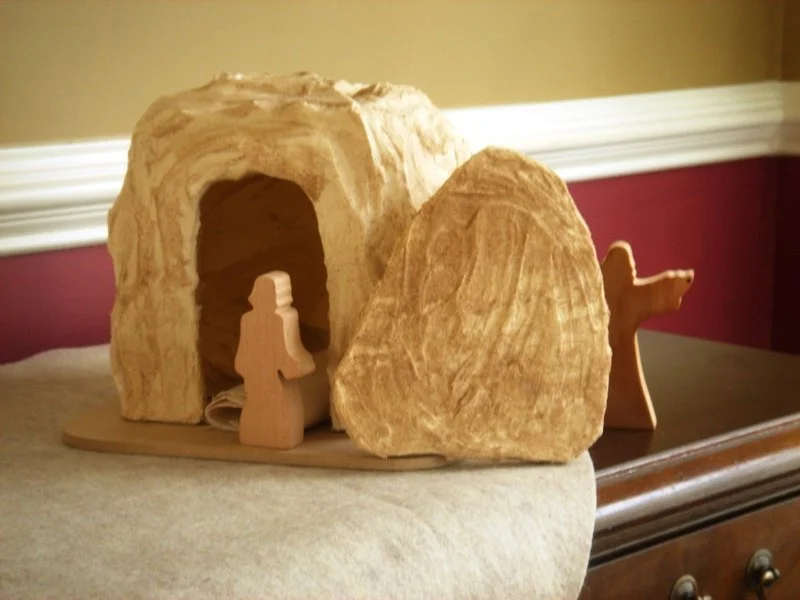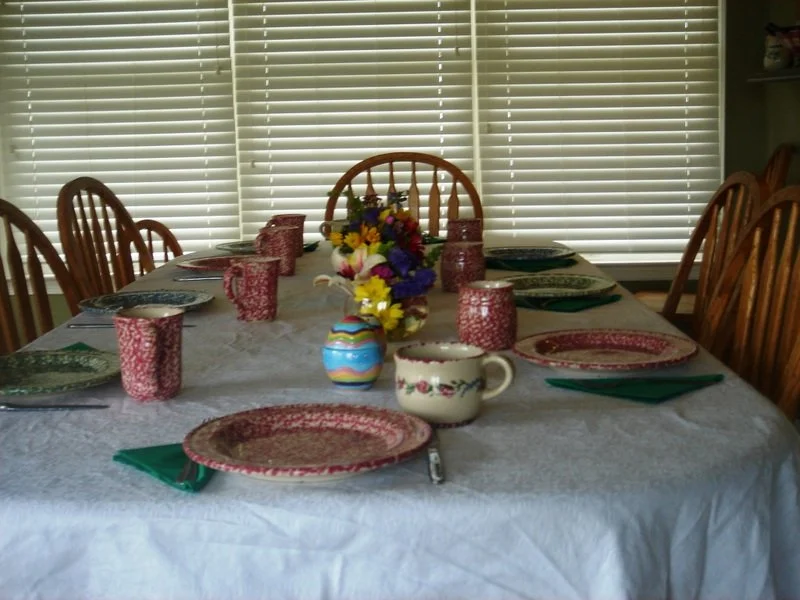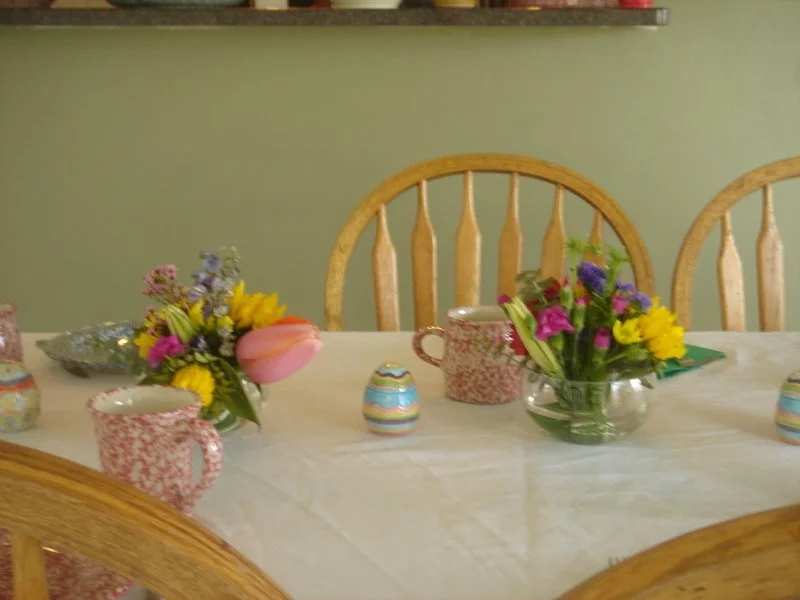Kim Fry talks frequently about starting with the little ones and building on that foundation. She doesn't mean just planning the littles' curriculum first and then planning the bigger kids'. She means to look at what you want the youngest ones to know and then to add layer upon layer so that the entire family's education looks like a rich tapestry. This makes so much sense--it is one of the beautiful joys of home education. And it is most evident in the way we approach handing on the faith in our home.
We want to begin with the knowledge that Christ is the Good Shepherd, the tender caretaker, who will call the child by name and protect and comfort her throughout her life. The Catechesis of the Good Shepherd program is a tangible way to do that. An atrium is a place set apart for a child to encounter and fall in love with God.
Maria Montessori had such a place in her Children's Houses and Sofia Cavaletti has taken the idea into this century. Works in the atrium introduce children to the Good Shepherd and teach them parables and prophecies and the history of the salvation of man, using hands-on materials and a respect for the silence necessary for the child to encounter God. It's a concept rooted in liturgy. Moira Farrell has captured the essence of the atrium for mothers teaching their children at home. Her albums are a great beginning, though not exactly what you find in an institutional atrium. It's a double-edged sword. Montessori education was designed for groups of same-aged children. That was Dr. Montessori's premise and she played off the effects of children on each other. When we bring it home, we gain and we lose. We lose some of the peer consort group influence. But we also gain because we experience the presentations as a family. And, in many instances, parish atria are crippled by the "after school" culture. Remember, Montessori's students were in her Children's Houses all day. They were well-trained and well practiced in the disciplines of silence. Children who are trained to listen to God in the company of their families are blessed indeed.
Modeled after the atria in Maria Montessori's schools over a century ago, this method of listening to God with children has been developed over time by women such as Sofia Cavaletti (who is Catholic) and adapted by folks like Jerome Berryman and Sonja Stewart (who are not Catholic). The books they've written and the oral tradition of the Catechesis of the Good Shepherd training that is based on their work are true treasures. But the work of Moira Farrell--together with the materials designed and made available by her mother, Julia Fogassy--are what enable home educators--who believe that all of life is an opportunity to learn and home is the most beautiful of all classrooms--to make their homes into atria, and so to bring to life the Domestic Church. And, of course, there is ongoing discussion of the atrium at the 4reallearning message boards, to help you flesh it all out.
For as long as there have been children in my house, there have been storybooks. Stories embed themselves in a child's heart and live there forever. It makes good sense to tell children stories of the saints and of traditions and of the Bible. Jesus left us a treasury of stories; it is our joy-filled duty to share those stories with our children. And so, we do. We have shelves of picture books that grow into shelves of chapter books that grow into a full-blown spirituality and apologetics library. We read about God and his followers throughout the day, every day.
My preschoolers have delighted in The Catholic Children's Treasure Box. Very old-fashioned in pictures and words, these books touch children in a way that is inexplicable. They are pricey--collect them slowly; they're well worth the investment.
This year, we are blessed to have Catholic Mosaic to bring together some of the best of children's religious picture books in an organized manner and to offer suggestions for using those books. I've gushed about this concept before and I'm still gushing. It's a great idea. Handing on the faith through stories is an age-old idea that we all must make our own. While with most reading lists, the library is often the first place to look, I recommend purchasing most of the Mosaic books. The books will become a part of the family, to be read again and again, layer upon layer, as children grow and understand more deeply. The titles can be gift suggestions for grandparents and godparents and anyone who is interested in supporting the growing soul of the child.

Environment and atmosphere matter greatly when it comes to living holy lives. Truthfully, we are striving to make our entire homes shine with the presence of the Holy Spirit and envelope us with the comfort of Our Lady's mantle. We've tried to incorporate our atrium into our learning room. We've stored our picture books on two hand-me-down nightstands, placed below the Mary shelf we made in May. On the top of one nightstand, one book is highlighted--the book which is most closely represents the current feast of the Church. On the other nightstand is the Bible stand, a Good Shepherd statue, and a candle, all on a cloth appropriate for the liturgical season. That is our prayer table.
On the floor next to the prayer table is the Good Shepherd work. With this, the concept of the Good Shepherd is first introduced and then, as the child grows closer to Christ, is expanded to include the meaning of Communion.


Several years ago, when my oldest daughter began her time in our parish atrium, I wanted a tanglible way to record what she was learning and to integrate it with our story books. At the same time, Alice was preparing her daughter for First Communion. She generously shared her ideas for a First Communion notebook. I adapted those ideas for Mary Beth's unique experience and we began a family tradition. Slowly, over a child's fifth and sixth year, my children create notebooks with narrations of all that they see and do and hear in the atrium work and all that they learn from the stories. The preschool experience of Catechesis of the Good Shepherd and lots of stories of faith naturally grow into their first real academic "publication." These notebooks are treasures for the child and the parent alike. I love this time of preparation and of growing closer both to God and to my child.

On the next shelving unit, I've stored several atrium works. In the little baskets are small parable sets. Below them a child finds Noah's Ark, the ten commandments, the nativity, and several other presentations. These rotate, depending on interest and season. For instance, after our baby is born, I will present the baptism work and leave it there for my little ones to practice again and again. Following Moira's outline, but adapting it to our family, we can strike a balanced program that is uniquely ours but blessed by the talent and hard work of others.

The next table is the miniature altar. We've done those presentations again and again and the older children like to present them to the younger ones. Slowly, layer upon layer, an understanding of the Mass and an appreciation for the Mass is cultivated. As the children grow, this early experience will blossom into notebook projects like the lovely Easter Vigil notebook Alice designed and shared so generously a couple of years ago.
The liturgy is to be infused in our homes, to influence our choice of menus, home decoration, and family celebrations. And then there is handwork. Small children love to make something beautiful for God. I am indebted to the Alice for the wealth of ideas at Cottage Blessings and her capable and inspired moderation of the Living Faith message board. That's probably more than enough (especially when you have an occasional themed tea party). But to have just a little extra inspiration, there are A Year with God and the well-loved classic, The Year and Our Children to provide ideas for bringing the liturgical year to life.
These elements--the atrium, the stories, and living the liturgical year--are the foundation of our "religious education program." From this foundation, the children grow to gain an understanding of catechism and apologetics, Bible history and morality. Hour by hour, day by day, year by year, we watch each child grow closer to God in his or her unique way. But each one of them, from the time they are very little, has personal relationship with the Good Shepherd and a solid understanding of His message.
Earlier in the preschool series:
It's a wonderful thing!
The Art Box
Language Arts for Little Ones
Number Fun
Next up: Practical Life

















